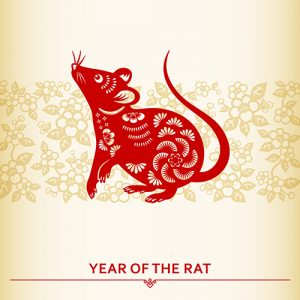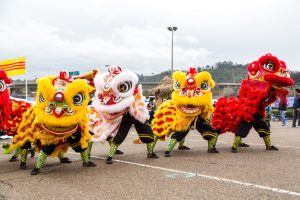January 25, 2020 - Lunar/Chinese New Year
We did a post last year on the lunar new year, but a few readers said that we didn't quite get it right. We edited the post at the time to include more information. However we thought it was worth revisiting this holiday, and re-doing our research for this post this year.
Lunar new year is most commonly known as the Chinese New Year, but other East Asian cultures celebrate the holiday as well. The date of the lunar new year changes from year to year, because the Chinese religious/cultural calendar (and other East Asian calendars) operate on a lunisolar calendar. The lunar new year takes place on the second new moon after the winter solstice.

When the Republic of China adopted the Gregorian calendar in 1912, they changed the name of the celebration from Lunar New Year (which had religious connotations) to Spring Festival. It is still winter in China. The name Spring Festival refers to the celebration of the coming spring, and not to the current season.
Each year begins the year of a new animal on the Chinese zodiac, that cycle through various animals every twelve years. This year will be the year of the Rat, the first animal in the Chinese zodiac. In Chinese culture, rat symbolizes intelligence and quick-wit. According to legend, the Jade Emperor held a race for a group of animals on his birthday. The results of the race determined the order they appeared on the Chinese zodiac. As the story goes, the rat got a ride on the back of the ox, and jumped off right before the finish line to win first place (ahead of the ox, who came in second). Famous people born in the year of the rat include: William Shakespeare, Rosa Parks, President H.W. Bush, Pope Francis, Katy Perry, and Laverne Cox.
The Lunar New Year is celebrated in China, South Korea, Tibet, Vietnam, Singapore, Malaysia, Hong Kong, and other places with large Chinese populations. Korean populations also call this celebration also as Seollal. We covered Chinese customs for this holiday in our post last year, so we’ll talk about Korean and Vietnamese customs this year. For Seollal, Koreans believe that ghosts come to the human world on the night before Seollal. The ghosts take the shoes that fit them, and when they do that, it brings bad luck to the owners of the shoes. To prevent this from happening, people hide their shoes the night before. The traditional Korean New Year’s meal is called duk gook. Duk gook is a soup made of thinly sliced rice cakes. In Korean culture, everyone turns a year older once they have finished their duk gook, and not on their birthday.
Vietnamese culture refers to the Lunar New Year as Tet. Tet is short for Tet Nguyen Dan, which translates as “Feast of the First Morning of the First Day.” Tet is about settling debts, forgetting the past, and starting new. This involves gift-giving, cleaning the home, cooking food and spending time with friends and family. Kids are also given “lucky money,” which is money in red envelopes. The oldest members of the family also receive money, which ensures their next year will be full of good health.
Traditional food for this holiday is sticky rice cake, mung beans, and pork. The rice cake is called Banh day, and it is also served with Vietnamese sausage. During the Tet holiday, observers try not to fight, as arguments could attract bad spirits.
For the Chinese/Lunar New Year, check out our upcoming new year events at the library.
To learn more about the holiday and celebrations, check out one of these items:
Mindy Kim and the Lunar New Year Parade



Add a comment to: The Origins and Practices of Lunar/Chinese New Year